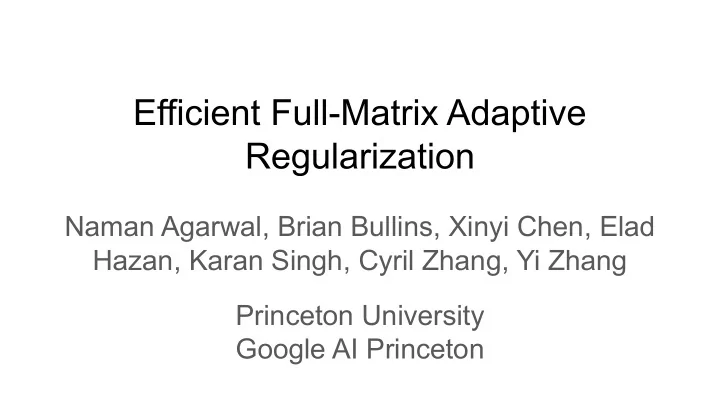

Efficient Full-Matrix Adaptive Regularization Naman Agarwal, Brian Bullins, Xinyi Chen, Elad Hazan, Karan Singh, Cyril Zhang, Yi Zhang Princeton University Google AI Princeton
Adaptive Preconditioning in ML ● Optimization in ML: training neural nets → minimizing non-convex losses ● Diagonal Adaptive Optimizers: each coordinate has a different learning rate according to past gradients ○ AdaGrad, Adam, RMSProp ○ Works well in practice Theory is only known for convex losses at the time
Adaptive Preconditioning: Intuition Learns the correct basis, Doesn’t adapt to a rotated basis faster optimization Diagonal Full-Matrix Expensive! Can we have a linear time algorithm?
Our Results ● GGT: a new adaptive optimizer Efficient full-matrix (low-rank) AdaGrad ● Experiments : faster training and sometimes better generalization on vision and language tasks ● GPU-friendly Implementation ● Theory : “adaptive” convergence rate on convex and non-convex functions ● Up to O(1/√d) faster than SGD
The GGT Trick ● Scalar Case: ● Matrix Case:
The GGT Trick ● Scalar Case: ● Matrix Case:
The GGT Trick ● Scalar Case: ● Matrix Case: Efficient implementation on the GPU!
Large-Scale Experiments (CIFAR-10, PTB) ● Resnet-26 for CIFAR-10 and LSTM for PTB ● Better and faster training ● Initial acceleration in optimizing the LSTM ● Better validation ppl for the LSTM
Theory ● Define the adaptivity ratio : [DHS10]: for diagonal AdaGrad, sometimes smaller for full-matrix AdaGrad ● Non-Convex reduction : GGT* converges in steps ● First step towards analyzing adaptive methods in non-convex optimization * Idealized modification of GGT for analysis. See paper for details.
A note on the important parameters ● Improving dependence on epsilon: In practice , leading to an improvement of about 3.1 ● Instead our improvement can be as large as the dimension, which can be 1e7 for language models ● Huge untapped potential for large-scale optimization!
Thank You! Poster #209 xinyic@google.com
Recommend
More recommend